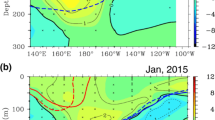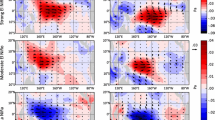Abstract
Westerly wind bursts (WWBs) that occur in the western tropical Pacific are believed to play an important role in the development of El Niño events. Here, following the study of Lengaigne et al. (Clim Dyn 23(6):601–620, 2004), we conduct numerical simulations in which we reexamine the response of the climate system to an observed wind burst added to a coupled general circulation model. Two sets of twin ensemble experiments are conducted (each set has control and perturbed experiments). In the first set, the initial ocean heat content of the system is higher than the model climatology (recharged), while in the second set it is nearly normal (neutral). For the recharged state, in the absence of WWBs, a moderate El Niño with a maximum warming in the central Pacific (CP) develops in about a year. In contrast, for the neutral state, there develops a weak La Niña. However, when the WWB is imposed, the situation dramatically changes: the recharged state slides into an El Niño with a maximum warming in the eastern Pacific, while the neutral set produces a weak CP El Niño instead of previous La Niña conditions. The different response of the system to the exact same perturbations is controlled by the initial state of the ocean and the subsequent ocean–atmosphere interactions involving the interplay between the eastward shift of the warm pool and the warming of the eastern equatorial Pacific. Consequently, the observed diversity of El Niño, including the occurrence of extreme events, may depend on stochastic atmospheric processes, modulating El Niño properties within a broad continuum.
















Similar content being viewed by others
References
An SI, Jin FF (2001) Collective role of thermocline and zonal advective feedbacks in the ENSO mode. J Clim 14(16):3421–3432. doi:10.1175/1520-0442(2001)014<3421:Crotaz>2.0.Co;2
Ashok K, Behera SK, Rao SA, Weng HY, Yamagata T (2007) El Nino Modoki and its possible teleconnection. J Geophys Res-Oceans 112(C11). doi:10.1029/2006jc003798
Battisti DS, Hirst AC (1989) Interannual variability in a tropical atmosphere ocean model—influence of the basic state, ocean geometry and nonlinearity. J Atmos Sci 46(12):1687–1712. doi:10.1175/1520-0469(1989)046<1687:Iviata>2.0.Co;2
Boulanger JP, Menkes C (1999) Long equatorial wave reflection in the Pacific Ocean from TOPEX/POSEIDON data during the 1992–1998 period. Clim Dyn 15(3):205–225. doi:10.1007/S003820050277
Boulanger JP, Menkes C, Lengaigne M (2004) Role of high-and low-frequency winds and wave reflection in the onset, growth and termination of the 1997–1998 El Nino. Clim Dyn 22(2–3):267–280
Clarke AJ (2008) An introduction to the dynamics of El Nino & the southern oscillation. Academic Press, London
Clarke AJ (2010) Analytical theory for the quasi-steady and low-frequency equatorial ocean response to wind forcing: the “Tilt” and “Warm Water Volume” modes. J Phys Oceanogr 40(1):121–137. doi:10.1175/2009jpo4263.1
Ding QH, Steig EJ, Battisti DS, Kuttel M (2011) Winter warming in West Antarctica caused by central tropical Pacific warming. Nat Geosci 4(6):398–403. doi:10.1038/Ngeo1129
Drushka K, Bellenger H, Guilyardi E, Lengaigne M, Vialard J, Madec G (2014) Processes driving intraseasonal displacements of the eastern edge of the warm pool: the contribution of westerly wind events. Clim Dyn (submitted)
Eisenman I, Yu LS, Tziperman E (2005) Westerly wind bursts: ENSO’s tail rather than the dog? J Clim 18(24):5224–5238. doi:10.1175/Jcli3588.1
Fedorov AV (2002) The response of the coupled tropical ocean-atmosphere to westerly wind bursts. Q J R Meteor Soc 128(579):1–23
Fedorov AV (2010) Ocean response to wind variations, warm water volume, and simple models of ENSO in the low-frequency approximation. J Clim 23(14):3855–3873. doi:10.1175/2010jcli3044.1
Fedorov AV, Philander SG (2000) Is El Nino changing? Science 288(5473):1997–2002. doi:10.1126/Science.288.5473.1997
Fedorov AV, Philander SG (2001) A stability analysis of tropical ocean-atmosphere interactions: bridging measurements and theory for El Nino. J Clim 14(14):3086–3101. doi:10.1175/1520-0442(2001)014<3086:Asaoto>2.0.Co;2
Fedorov AV, Harper SL, Philander SG, Winter B, Wittenberg A (2003) How predictable is El Nino? B Am Meteorol Soc 84(7):911. doi:10.1175/Bams-84-7-911
Gebbie G, Eisenman I, Wittenberg A, Tziperman E (2007) Modulation of westerly wind bursts by sea surface temperature: a semistochastic feedback for ENSO. J Atmos Sci 64(9):3281–3295
Gierach MM, Lee T, Turk D, McPhaden MJ (2012) Biological response to the 1997–98 and 2009–10 El Nino events in the equatorial Pacific Ocean. Geophys Res Lett 39. doi:10.1029/2012gl051103
Giese BS, Ray S (2011) El Niño variability in simple ocean data assimilation (SODA), 1871–2008. J Geophys Res-Oceans 116(C2). doi:10.1029/2010JC006695
Guilyardi E (2006) El Niño–mean state–seasonal cycle interactions in a multi-model ensemble. Clim Dyn 26(4):329–348
Hu S, Fedorov AV, Lengaigne M, Guilyardi E (2014) The impact of westerly wind bursts on the diversity, and predictability of El Niño events: an ocean energetics perspective. Geophys Res Lett (in revision)
Hu ZZ, Kumar A, Jha B, Wang WQ, Huang BH, Huang BY (2012) An analysis of warm pool and cold tongue El Nios: air-sea coupling processes, global influences, and recent trends. Clim Dyn 38(9–10):2017–2035. doi:10.1007/S00382-011-1224-9
Jin FF (1997a) An equatorial ocean recharge paradigm for ENSO.1. Conceptual model. J Atmos Sci 54(7):811–829. doi:10.1175/1520-0469(1997)054<0811:Aeorpf>2.0.Co;2
Jin FF (1997b) An equatorial ocean recharge paradigm for ENSO.2. A stripped-down coupled model. J Atmos Sci 54(7):830–847. doi:10.1175/1520-0469(1997)054<0830:Aeorpf>2.0.Co;2
Jin FF, Neelin JD (1993a) Modes of interannual tropical ocean–atmosphere Interaction—a unified view. 1. Numerical results. J Atmos Sci 50(21):3477–3503. doi:10.1175/1520-0469(1993)050<3477:Moitoi>2.0.Co;2
Jin FF, Neelin JD (1993b) Modes of interannual tropical ocean–atmosphere interaction—a unified view. 3. Analytical results in fully coupled cases. J Atmos Sci 50(21):3523–3540. doi:10.1175/1520-0469(1993)050<3523:Moitoi>2.0.Co;2
Kao HY, Yu JY (2009) Contrasting eastern-Pacific and central-Pacific types of ENSO. J Clim 22(3):615–632. doi:10.1175/2008jcli2309.1
Kessler WS (2002) Is ENSO a cycle or a series of events? Geophys Res Lett 29(23). doi:10.1029/2002gl015924
Kim HM, Webster PJ, Curry JA (2009) Impact of shifting patterns of Pacific Ocean warming on north Atlantic tropical cyclones. Science 325(5936):77–80. doi:10.1126/Science.1174062
Kug JS, Jin FF, An SI (2009) Two types of El Nino events: cold tongue El Nino and warm pool El Nino. J Clim 22(6):1499–1515. doi:10.1175/2008jcli2624.1
Kumar KK, Rajagopalan B, Hoerling M, Bates G, Cane M (2006) Unraveling the mystery of Indian monsoon failure during El Nino. Science 314:115–119
L'Heureux ML, Collins DC, Hu ZZ (2013) Linear trends in sea surface temperature of the tropical Pacific Ocean and implications for the El Nino-Southern Oscillation. Clim Dyn 40(5–6):1223–1236. doi:10.1007/S00382-012-1331-2
Larkin NK, Harrison DE (2005) On the definition of El Nino and associated seasonal average US weather anomalies. Geophys Res Lett 32(13). doi:10.1029/2005gl022738
Lee T, McPhaden MJ (2010) Increasing intensity of El Nino in the central-equatorial Pacific. Geophys Res Lett 37. doi:10.1029/2010gl044007
Lengaigne M, Vecchi GA (2010) Contrasting the termination of moderate and extreme El Nino events in coupled general circulation models. Clim Dyn 35(2–3):299–313
Lengaigne M, Boulanger JP, Menkes C, Masson S, Madec G, Delecluse P (2002) Ocean response to the March 1997 Westerly Wind Event. J Geophys Res-Oceans 107(C12). doi:10.1029/2001jc000841
Lengaigne M, Boulanger JP, Menkes C, Madec G, Delecluse P, Guilyardi E, Slingo J (2003) The March 1997 Westerly Wind Event and the onset of the 1997/98 El Nino: understanding the role of the atmospheric response. J Clim 16(20):3330–3343. doi:10.1175/1520-0442(2003)016<3330:Tmwwea>2.0.Co;2
Lengaigne M, Guilyardi E, Boulanger JP, Menkes C, Delecluse P, Inness P, Cole J, Slingo J (2004) Triggering of El Nino by westerly wind events in a coupled general circulation model. Clim Dyn 23(6):601–620. doi:10.1007/S00382-004-0457-2
Lengaigne M, Boulanger JP, Menkes C, Spencer H (2006) Influence of the seasonal cycle on the termination of El Niño events in a coupled general circulation model. J Clim 19(9):1850–1868
Lian T, Chen D (2012) An evaluation of rotated EOF analysis and its application to tropical Pacific SST variability. J Clim 25(15):5361–5373
Lopez H, Kirtman BP, Tziperman E, Gebbie G (2013) Impact of interactive westerly wind bursts on CCSM3. Dyn Atmos Oceans 59:24–51. doi:10.1016/J.Dynatmoce.2012.11.001
McPhaden MJ (1999) Genesis and evolution of the 1997–1998 El Nino. Science 283(5404):950–954. doi:10.1126/Science.283.5404.950
McPhaden MJ, Yu X (1999) Equatorial waves and the 1997–1998 El Nino. Geophys Res Lett 26(19):2961–2964. doi:10.1029/1999gl004901
McPhaden MJ, Lee T, McClurg D (2011) El Niño and its relationship to changing background conditions in the tropical Pacific Ocean. Geophys Res Lett 38(15):L15709
Neelin JD, Jin FF (1993) Modes of interannual tropical ocean–atmosphere interaction—a unified view. 2. Analytical results in the weak-coupling limit. J Atmos Sci 50(21):3504–3522. doi:10.1175/1520-0469(1993)050<3504:Moitoi>2.0.Co;2
Newman M, Shin SI, Alexander MA (2011) Natural variation in ENSO flavors. Geophys Res Lett 38(14). doi:10.1029/2011GL047658
Nicholls N (2008) Recent trends in the seasonal and temporal behaviour of the El Nino-Southern Oscillation. Geophys Res Lett 35(19). doi:10.1029/2008gl034499
Philander SG (1990) El Niño, La Niña, and the southern oscillation International geophysics series, vol 46. Academic Press, San Diego
Philander SG, Fedorov A (2003) Is El Nino sporadic or cyclic? Annu Rev Earth Pl Sc 31:579–594. doi:10.1146/Annurev.Earth.31.100901.141255
Rasmusson EM, Carpenter TH (1982) Variations in tropical sea surface temperature and surface wind fields associated with the Southern Oscillation/El Niño. Mon Weather Rev 110(5):354–384
Sarachik ES, Cane MA (2010) The El Niño-Southern oscillation phenomenon. Cambridge University Press, Cambridge, New York
Schopf PS, Suarez MJ (1988) Vacillations in a coupled ocean atmosphere model. J Atmos Sci 45(3):549–566. doi:10.1175/1520-0469(1988)045<0549:Viacom>2.0.Co;2
Shi L, Hendon HH, Alves O, Wheeler MC, Anderson D, Wang G (2011) On the importance of initializing the stochastic part of the atmosphere for forecasting the 1997/1998 El Niño. Clim Dyn 37(1–2):313–324
Takahashi K, Montecinos A, Goubanova K, Dewitte B (2011) ENSO regimes: Reinterpreting the canonical and Modoki El Niño. Geophys Res Lett 38(10). doi:10.1029/2011GL047364
Thompson CJ, Battisti DS (2000) A linear stochastic dynamical model of ENSO. Part I: model development. J Clim 13(15):2818–2832. doi:10.1175/1520-0442(2000)013<2818:Alsdmo>2.0.Co;2
Thompson CJ, Battisti DS (2001) A linear stochastic dynamical model of ENSO. Part II: analysis. J Clim 14(4):445–466. doi:10.1175/1520-0442(2001)014<0445:Alsdmo>2.0.Co;2
Trenberth KE, Stepaniak DP (2001) Indices of El Niño evolution. J Clim 14(8):1697–1701
Vecchi GA, Wittenberg AT, Rosati A (2006) Reassessing the role of stochastic forcing in the 1997–1998 El Niño. Geophys Res Lett 33(1). doi:10.1029/2005GL024738
Wang CZ (2001) A unified oscillator model for the El Nino-Southern Oscillation. J Clim 14(1):98–115. doi:10.1175/1520-0442(2001)014<0098:Auomft>2.0.Co;2
Wyrtki K (1975) El Nino—dynamic-response of equatorial pacific ocean to atmospheric forcing. J Phys Oceanogr 5(4):572–584. doi:10.1175/1520-0485(1975)005<0572:Entdro>2.0.Co;2
Yeh SW, Kirtman BP, Kug JS, Park W, Latif M (2011) Natural variability of the central Pacific El Nino event on multi-centennial timescales. Geophys Res Lett 38. doi:10.1029/2010gl045886
Yeh SW, Kug JS, Dewitte B, Kwon MH, Kirtman BP, Jin FF (2009) El Nino in a changing climate. Nature 461(7263):511–514. doi:10.1038/Nature08316
Yu JY, Kao HY (2007) Decadal changes of ENSO persistence barrier in SST and ocean heat content indices: 1958–2001. J Geophys Res-Atmos 112(D13). doi:10.1029/2006jd007654
Yu JY, Kim ST (2010) Three evolution patterns of Central-Pacific El Nino. Geophys Res Lett 37. doi:10.1029/2010gl042810
Yu JY, Kim ST (2011) Relationships between extratropical sea level pressure variations and the Central Pacific and Eastern Pacific types of ENSO. J Clim 24(3):708–720. doi:10.1175/2010jcli3688.1
Zubiaurre I, Calvo N (2012) The El Nino-Southern Oscillation (ENSO) Modoki signal in the stratosphere. J Geophys Res-Atmos 117. doi:10.1029/2011jd016690
Acknowledgments
This research was supported by Grants from NSF (AGS-1116885), DOE Office of Science (DE-SC0007037), the David and Lucile Packard Foundation, and the Agence Nationale de la Recherche (ANR) project METRO (2010-BLAN-616-01).
Author information
Authors and Affiliations
Corresponding author
Rights and permissions
About this article
Cite this article
Fedorov, A.V., Hu, S., Lengaigne, M. et al. The impact of westerly wind bursts and ocean initial state on the development, and diversity of El Niño events. Clim Dyn 44, 1381–1401 (2015). https://doi.org/10.1007/s00382-014-2126-4
Received:
Accepted:
Published:
Issue Date:
DOI: https://doi.org/10.1007/s00382-014-2126-4




